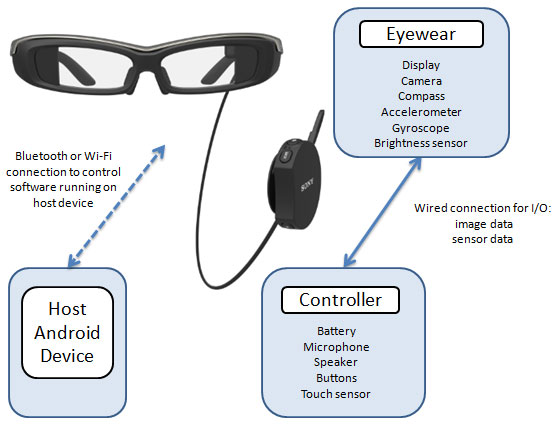Sony Releases Developer Version of SmartEyeglass, Google Glass Alternative
With the team behind Google Glass going back to the drawing board to rethink and redesign their much-awaited smart glasses, Sony is taking the initiative to enter into the augmented reality market themselves with a product they're calling “SmartEyeglass.”
Sales of the Google Glass “explorer edition” halted in January 2015 due to bad reception in the media and amongst consumers. After news that many developers were abandoning their Google Glass development projects, and a litany of critics referring to Glass wearers as “Glassholes,” the team at Google finally decided it was time to “re-organize and re-imagine” the product, resulting in the postponed Glass project being transferred to the Nest division of Google, spearheaded by Tony Fadell.
In the meantime, Sony was hard at work creating its own pair of augmented reality (AR) glasses, which they've recently announced are available for pre-order in the United Kingdom and Germany, and are set to be made available in 8 other countries – the U.S, Italy, France, Spain, Japan, Sweden, Belgium, and the Netherlands - by next month. The current official product name is SmartEyeglass Developer Edition (SED-E1). Sony has stated that it plans to release the consumer version of SmartEyeglass to the general public at some point in 2016.
Developers can already download the SmartEyeglass SDK, and Sony has suggested a number of concepts for developers to get started on, including an app that could share live sports stats while the wearer is watching the game, displaying tourist information while the wearer is sightseeing, and even providing holographic instructions to assemble an engine. While these are just concepts, they give developers an idea of some nifty applications that the upcoming AR glasses could be used for. Before we continue, check out Sony's preliminary trailer for SmartEyeglass:
Half the Cost of Google Glass, Available as an Accessory As Well
Perhaps the biggest difference between Google Glass and Sony's entry into the field is the pricetag – Sony's developer version of SmartEyeglass costs about $840, which is a little more than half the price of the Glass explorer edition ($1500).
In addition to the standalone SmartEyeglass headset, we also learned back in December that Sony is working on a clip-on attachment that will turn any pair of glasses into a pair of AR goggles. The clip-on attachment is being called “SmartEyeglass Attach,” and is expected to come equipped with an OLED microdisplay, an optical unit, and a control board similar to the one Google Glass uses.
Specs and Key Features
Sony's standalone SmartEyeglass works by superimposing monochrome text into the wearer's field of vision using “holographic waveguide technology” that gives the glasses 85% transparency. The device is equipped with a microphone, CMOS image sensor, electronic compass, gyroscope, accelerometer, and brightness sensor. There's also a 3-megapixel camera mounted behind the left lens. The picture below provides a basic illustration of the setup:
The device will be able to connect to any Android smartphone, and any apps ran in the glasses will actually be running on the connected smartphone and displayed in the glasses via WiFi or bluetooth.
There will be a decent selection of popular Android apps (i.e. - Facebook, Twitter, Gmail, voice control, RSS, and calendar) available for SmartEyeglass in Google Play, and most likely there will be plans to create iOS versions as well. Users will be able to quickly find these apps via the main SmartEyeglass app on their smartphone.
By making the SDK available more than a year before the commercial launch, Sony hopes to attract the attention and contributions of a large group of developers and early adopters.
Uglier Than Google Glass, or Made for a Different Purpose?
One of the main problems with Google Glass was the perceived nerdiness of the device, making the wearer look more like a snobby cyborg than an adventurous techie. Unfortunately, Sony apparently didn't address the nerd factor either when they designed the developer's edition of their SmartEyeglass, which is surprisingly more bulky and unsightly than Google Glass.
At least Google partnered with the Luxottica Group (the company that owns RayBan and Oakley) to produce stylish frames for the consumer version of Glass. Of course the other huge problem with Google Glass was that it had a small camera mounted in it (as does Sony's SmartEyeglass), prompting many onlookers to insult it as a glorified spy device.
If Google was smart enough to see that the general public wasn't ready to accept their version of AR, then why didn't Sony take measures to make their product more aesthetically acceptable?
It seems that Sony might have a different vision for SmartEyeglass. Instead of having it become an uber-popular consumer product worn by the random guy on the street, Sony's AR glasses may be geared more towards specialized uses such technical training, product assembly, statistical analysis, mechanical engineering, and other activities that could be enhanced through the use of a hands-free instructional device with text overlay and voice control capabilities.
AR Glasses for AR Uses
 Marketing the SmartEyeglass as a genuinely useful holographic information tool may be more accepted by consumers than the one-size-fits-all, disguised-as-regular-glasses approach that Google Glass initially took.
Marketing the SmartEyeglass as a genuinely useful holographic information tool may be more accepted by consumers than the one-size-fits-all, disguised-as-regular-glasses approach that Google Glass initially took.
Sony's device is so overly conspicuous that most people would not perceive it as an attempt at spying because it doesn't masquerade as a conventional pair of glasses, and it does actually look like something you might see a technician wearing during training.
In summary, Sony seems to be creating AR goggles for people and industries that actually have a genuine need for them, rather than producing a stylish tech gadget for hipsters to walk around the streets of New York City with snapping pics of landmarks (Google Glass).
In other words, while Google seemed to be aggressively marketing Glass to everyone in an attempt to bring AR to the masses, Sony seems to have more practical goals for their SmartEyeglass project.
The aforementioned points have probably already been taken into consideration by Google, which is most likely why they've opted to transfer the development of Glass to the Nest unit, which is responsible for making “smart home” products. Apparently Google has realized that people are much more likely to wear AR goggles in-and-around the house (or workplace) than to wear them to a casual outing to Starbucks (nobody wants to be called a Glasshole). While moving the Glass project over to Nest seems like a sensible decision, one has to wonder whether it will really help the project's publicity, considering recent complaints about the false-alarming Nest Protect smoke alarm.

